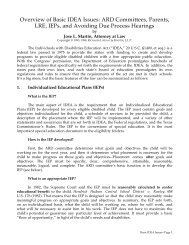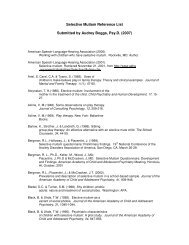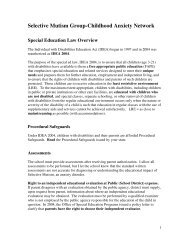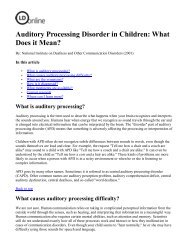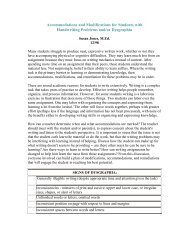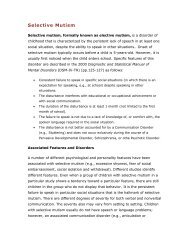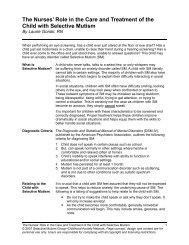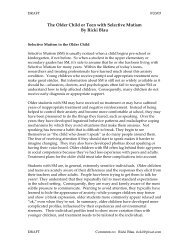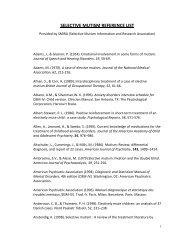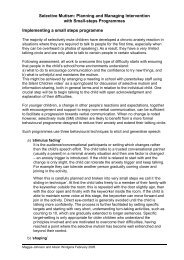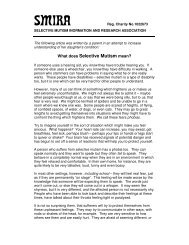Selective Mutism
to get the file - Selective Mutism Group
to get the file - Selective Mutism Group
You also want an ePaper? Increase the reach of your titles
YUMPU automatically turns print PDFs into web optimized ePapers that Google loves.
<strong>Selective</strong> <strong>Mutism</strong>http://www.asha.org/public/speech/disorders/<strong>Selective</strong>-<strong>Mutism</strong>.htmPage 2 of 52/19/2007The speech-language pathologist works as part of a collaborative, interdisciplinaryteam consisting of the pediatrician, a psychologist or psychiatrist, the teacher(s),and the family. The speech-language pathologist will conduct a thorough parentalinterview , as most children who are selectively mute will not talk to the clinician.Use Find a Professional to locate a speech-language pathologist near you.This interview seeks information on:the child's symptom history, especially focusing on the onset of the behaviors. Themajority of children with selective mutism do not have a sudden onset of symptomsthe degree to which the child is verbally and non-verbally inhibited, whichmay vary from setting to setting . Parents may be asked to provide informationabout the child's relationships with friends or to describe how the child communicatesin social situations outside of school (e.g., interacting with other children and adultson the playground or talking on the telephone).associated problems (e.g., schizophrenia, pervasive developmental disorder) thatcould be contributing to the failure to speak. It is possible to rule out selectivemutism if one of these are present.the child's speech and language development, as well as current use andcomprehension of language. Does the child understand what people say to him orher? Does the child understand questions and follow directions? Is the child able tofind the words needed to express ideas? The parent may be asked to describe thechild's speech production (i.e., pronunciation of words, quality/tone/pitch of voice,fluency of speech) to help rule out any other speech and language disabilities thatcould be causing or exacerbating the mutism. Current studies show that 20-30percent of children with selective mutism have other speech and languagedisabilities; however, these are not the cause of the mutism. It is important toaddress these speech and langaugedifficulties so the child can become morecomfortable with communication.any environmental influences (i.e., learning more than one language at a time ornot having adequate language stimulation) that may affect the child's comfort andconfidence with the language.family history of psychiatric (e.g., social phobia, obsessive-compulsive disorder, orother anxiety disorders) and personality (e.g., extreme shyness) diagnoses that maybe predisposing the child to mutism. The clinician reviews the child's medical historyto rule out physical problems (e.g., neurological delay) underlying the mutism.The speech-language pathologist will also review educational history viaacademic reports, parent/teacher comments, and standardized testing. Do thesereports indicate concern about the child's communication skills with peers oradults in the classroom? Are teachers concerned about the child's academicachievement? The clinician reviews the reports of any previous testing (e.g.,
<strong>Selective</strong> <strong>Mutism</strong>http://www.asha.org/public/speech/disorders/<strong>Selective</strong>-<strong>Mutism</strong>.htmPage 3 of 52/19/2007psychological) to assess whether other diagnosed disabilities could be causing orexacerbating the mutism.The speech-language pathologist will then conduct a speech and languageevaluation . The child’s anxiety level should be taken into account.Accommodations should be considered in order to evaluate the child incomfortable surroundings and with familiar people. A parent might be present tohelp facilitate communication. If any evaluation procedures are too anxietyprovoking they should be discontinued.The clinician interviews the child to observe the quality of verbal and non-verbalcommunication . This is done through informal play activities (e.g., playingtogether with a dollhouse and using the dolls and accessories to stimulate dialogueand social interaction). If the child is having difficulty participating in these playactivities, the clinician should try another type of activitiy. Drawing may be used as ameans to explore non-verbal communication skills.Comprehension of language is evaluated using standardized tests (e.g., the childis shown a set of four pictures and is told to point to one of the pictures) andinformal observation.The parent may be asked to do structured communication activities with thechild (e.g., have the child retell the plot of a story or describe a picture) to create aninformative videotape. The parent may also be asked to provide a videotape of thechild's speech at home during regular conversation. These samples enable thespeech-language pathologist to evaluate expressive language abilities (wordknowledge, use of grammar, ability to sequence a set of ideas, social communicationskills). The speech-language pathologist may attempt to conduct an oral-motorexamination to evaluate the strength and coordination of the muscles in the child'slips, jaw, and tongue. Muscle weakness or incoordination may signify a neurologicalimpairment that is may lead to a diagnosis other than selective mutism.S creening test for hearing and middle ear function should also be part of theevaluation.TreatmentThe speech-language pathologist may coordinate a behavioral treatmentprogram to increase verbalizations. Behavioral treatment is based on the premisethat the child who is selectively mute is using the behavior in response to anxietyin social situations. The focus of the speech-language pathologist’s intervention isto reinforce communication with a gradual progression from non-verbal to verbal.This may be accomplished through stimulus fading, in which the speech-languagepathologist sets simple goals (e.g., using a gesture to communicate) andgradually increases expectations until speech is achieved. Another behavioral
<strong>Selective</strong> <strong>Mutism</strong>http://www.asha.org/public/speech/disorders/<strong>Selective</strong>-<strong>Mutism</strong>.htmPage 4 of 52/19/2007treatment technique called shaping reinforces mouth movements thatapproximate speech (e.g., whispering) until true speech is achieved. Anothertechnique sometimes used, when the child is willing, isthe self-modeling techniquewhere the child watches videotapes of himself or herself performing the desiredbehavior (e.g., communicating effectively at home) to facilitate self-confidenceand carry-over of this behavior into the classroom. The speech-languagepathologist should collaborate with the psychologist, whose primary focus will beto help reduce the child’s anxiety.The speech-language pathologist may also work with specific speech andlanguage problems that are making the mute behavior worse. For example,some children with selective mutism are afraid to speak because they feel theymay say the wrong thing. The speech-language pathologist may use role-playingactivities to lessen the child's anxiety and increase confidence with speaking todifferent listeners in a variety of settings. Other children with selective mutismmay not want to speak because they feel their voice "sounds funny." If necessary,the speech-language pathologist may work on speech pronunciation to increasethe child's confidence and clarity of speech.Additionally, the speech-language pathologist likely will work in the child'sclassroom with teachers to encourage communication and lessen anxiety aboutspeaking. For example, the speech-language pathologist may help the teacherimplement the use of small, cooperative groups within the classroom that are lessintimidating for the child with selective mutism. Then, the speech-languagepathologist will work with the child within this group to facilitate more effectivecommunication with peers, first using non-verbal communication methods, suchas signals or cards, to contribute to small group discussions and gradually addinggoals to include speech. The speech-language pathologist will work with the child,family, and teachers to generalize learned communication behaviors into otherspeaking situations. The speech-language pathologist continues to work as part ofthe school-based interdisciplinary team to treat the child with selective mutism.The type of intervention will differ depending on the needs of the child and his orher family. The child's treatment may use a combination of strategies, againdepending on individual needs.How Common Is It?According to the DSM-IV, selective mutism is an apparently rare disorder thataffects fewer than 1% of individuals seen in mental health settings. (p. 126).ASHA Technical Information Packet
<strong>Selective</strong> <strong>Mutism</strong>http://www.asha.org/public/speech/disorders/<strong>Selective</strong>-<strong>Mutism</strong>.htmPage 5 of 52/19/2007Working With Children who Have <strong>Selective</strong> <strong>Mutism</strong>Item #0112293Order by calling ASHA product sales 1-888-498-6699 or by visiting our onlinestore.©1997-2007 American Speech-Language-Hearing Association -



